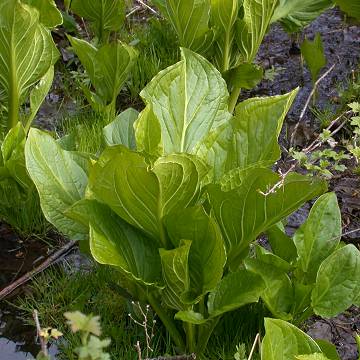

Symplocarpus foetidus - (image 1 of 6)
Taxonomy
Family: Araceae
Habitat
Calcareous fens and springy areas. Shaded seepage slopes. Wet-mesic swamps.
Associates
In fens with Angelica atropurpurea, Aster puniceus firmus, Caltha palustris, Cardamine bulbosa, Carex hystericina, Cirsium muticum, Equisetum arvense, Eupatorium maculatum, Impatiens capensis, Oxypolis rigidior, Pedicularis lanceolata, Solidago patula.
Distribution
Quebec and Nova Scotia south to NC, west to MN and IA. Also occurs in eastern Asia.
Morphology
Herbaceous perennial from a thick rhizome. Leaves basal, short petioled, ovate, cordate, to 2' high and 1' wide, veined. Flowers perfect, tiny; stamens 4; flowers covering a knob-like spadix and enclosed by a shell-like spathe; spathe ovoid with incurved summit, 3-6" long, green and purple or reddish, mottled, partially underground with a very short peduncle. Fruit globose, 3-4" thick; seeds 0.4" thick and embedded in the spongy spadix.
Notes
Flowers mid February to early May
Wetland indicator: Obligate
When bruised, the leaves emit a fetid skunk-like odor. The flowers emit heat via cellular respiration that melts the snow or ice around it. All parts of the plant contain calcium oxalate crystals, which produce an intense burning sensation when eaten. Only thorough drying destroys this property. The thoroughly dried leaves can be used in soups and stews and the dried root can be ground into flour.
References
Gleason, Henry A. and A. Cronquist. 1991. Manual of Vascular Plants of
Northeastern United States
and Adjacent Canada. Second Ed.
The New York Botanical Garden. Bronx, NY
Niering, W. A. 1979. The Audubon society field guide to North American
wildflowers: eastern region.
Knopf/Random House, New York.
Peterson, L. A. 1977. A Field Guide to Edible Wild Plants: Eastern and central
North America
Houghton Mifflin Company. New York, NY
Swink, F. and G. Wilhelm. 1994. Plants of the Chicago Region.
Indiana Academy of Science. The Morton Arboretum. Lisle, Illinois.
|
Michael Hough © 2005 |